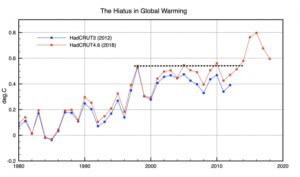by David Whitehouse, December 20, 2018 in GWPF
Using simple statistics it looked at and dismissed over 200 peer-reviewed papers that analysed the pause and concluded it was a real phenomenon. How did they, and the IPCC, get it all so wrong?

Source: Clive Best
Nobody who keeps an eye on climate research will be at all surprised by this “new” paper. Its conclusions were well aired in April 2018 at a meeting of the European Geophysical Union.
The authors must have been rather frustrated at the time as the paper describing their work had been submitted to the journal Environmental Research Letters over a year earlier, in February 2017 in fact, still had not been published. This was remedied a few days ago when it was finally published — one year and nine months after its submission!
…
by ‘Guest Blogger’, December 23, 2018 in WUWT
Obiter dictum. We acknowledge that seawater is basic and cannot truly acidify (pH<7). But that is a losing semantic quibble, not a winning skeptical argument. The generally accepted linguistic convention—for better or worse–is that lowering seawater pH means ‘acidification’. There is no doubt that adding dissolved CO2 does lower pH. The relevant questions are how much and whether that amount matters. This post answers both questions (a little, not much) without the two specific false alarms that motivated the ebook version.
There are certainly some ocean related AGW consequences beyond any scientific doubt. Henry’s Law requires that the partial pressures of atmospheric and dissolved ocean CO2equilibrate. Rising atmospheric CO2 must increase dissolved seawater CO2. That is long established simple physical chemistry.
This lowers pH by increasing carbonic acid. NOAA PMEL has documented this in the central Pacific at Station Aloha off Mauna Loa where sea surface pH has declined from 8.11 to 8.07 since 1991, as dissolved pCO2 increased from ≈325 to ≈360μatm while atmospheric CO2 increased from about 355 to 395 ppm. That is Δ0.04 pH in 24 years.
…
See also here (in French)
by RMIT ABC fact Check, December 21, 2018
The claim
Liberal MP and climate sceptic Craig Kelly made headlines in November when he was caught on tape mocking “lefties” for exaggerating the effects of climate change.
Speaking at a local party event, audio of which was leaked to the Guardian, Mr Kelly set out to debunk several justifications for climate change action, including the argument that Tuvalu, the Pacific island nation, was slipping beneath the sea.
“The science tells us that Tuvalu, which I often hear about, is actually growing not sinking,” he told colleagues.
Is Tuvalu growing? RMIT ABC Fact Check investigates.
The verdict
Mr Kelly’s claim checks out.
In the four decades to 2014, Tuvalu’s total land area grew by 73 hectares, or 2.9 per cent.
…
La géologie, une science plus que passionnante … et diverse

